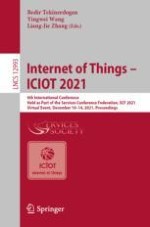2022 | Buch
Internet of Things – ICIOT 2021
6th International Conference, Held as Part of the Services Conference Federation, SCF 2021, Virtual Event, December 10–14, 2021, Proceedings
herausgegeben von: Bedir Tekinerdogan, Yingwei Wang, Liang-Jie Zhang
Verlag: Springer International Publishing
Buchreihe : Lecture Notes in Computer Science
